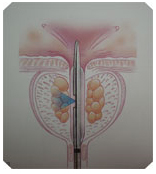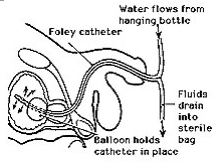(A) ENLARGED PROSATE ----- Benign prostatic hyperplasia (BPH)
BPH is the enlargement of the prostate, frequently occurring in men over the age of 50. The enlargement can result in a gradual squeezing of the urethra, sometimes causing difficulty in urinating.
Since the prostate lies in front of the rectum, your doctor will most likely perform a digital rectal examination (DRE) by inserting a gloved, lubricated finger into the rectum. By doing this, he or she will be able to feel the prostate and determine if it is enlarged or if it has lumps or other abnormalities.
Many doctors perform a prostate exam for men over the age of 50, or over the age of 45 for those with risk factors for prostate cancer, such as family history or African-American ethnicity.
No, BPH is not cancer and has not been shown to increase the risk of prostate cancer. However, both conditions can exist together. Check with your doctor about your concerns.
BPH generally does not interfere with sexual functioning.
Many men may not have any symptoms of BPH. If you do have symptoms, they may include:
- A weak urinary stream
- Difficulty starting urination
- Frequent urination
- Frequently awakening at night to urinate
It can also cause other urinary problems, such as urinary tract infections
An enlarged prostate is not reason enough to consider treatment. You and your doctor may decide on "watchful waiting," in which you are examined periodically to check the status of your prostate. Sometimes symptoms may lessen without active treatment. However, if symptoms from BPH are bothering you or are severely affecting the urinary tract, treatment may be required.
BPH can be treated with medications, nonsurgical procedures that use heat to destroy excess tissue, or surgery.
Medications work to relax the muscle tissue in the prostate or by reducing the amount of the hormone dihydrotestosterone (DHT).
Most doctors recommend the removal of the enlarged part of the prostate as the best long-term solution for patients with BPH.
With surgery for BPH, the enlarged tissue that is pressing against the urethra is removed. The rest of the prostate tissue and the outside capsule are left intact.
For a man whose symptoms are not severe enough to be bothersome, he and his physician may choose watchful waiting. This involves an exam by the physician to carefully monitor the progression of symptoms and possible complications.
Transurethral surgery (TURP) – BIPLAR SALINE TURP
In this type of surgery, no external incision is needed. After giving anesthesia, the surgeon reaches the prostate by inserting an instrument through the urethra.
A procedure called TURP (transurethral resection of the prostate) is used for 90 percent of all prostate surgeries done for BPH. With TURP, an instrument called a resectoscope is inserted through the penis. The resectoscope, which is about 12 inches long and 1/2 inch in diameter, contains a light, valves for controlling irrigating fluid, and an electrical loop that cuts tissue and seals blood vessels.
During the 90-minute operation, the surgeon uses the resectoscope's wire loop to remove the obstructing tissue one piece at a time. The pieces of tissue are carried by the fluid into the bladder and then flushed out at the end of the operation.
Most doctors suggest using TURP whenever possible. Transurethral procedures are less traumatic than open forms of surgery and require a shorter recovery period.
Another surgical procedure is called transurethral incision of the prostate (TUIP). Instead of removing tissue, as with TURP, this procedure widens the urethra by making a few small cuts in the bladder neck, where the urethra joins the bladder, and in the prostate gland itself. Although some people believe that TUIP gives the same relief as TURP with less risk of side effects such as retrograde ejaculation, its advantages and long-term side effects have not been clearly established.

Laser surgery

Laser TURP
In March 1996, FDA approved a surgical procedure that employs side-firing laser fibers and Nd: YAG lasers to vaporize obstructing prostate tissue. The doctor passes the laser fiber through the urethra into the prostate using a cystoscope and then delivers several bursts of energy lasting 30 to 60 seconds. The laser energy destroys prostate tissue and causes shrinkage. Like TURP, laser surgery requires anesthesia and a hospital stay. One advantage of laser surgery over TURP is that laser surgery causes little blood loss. Laser surgery also allows for a quicker recovery time. But laser surgery may not be effective on larger prostates. The long-term effectiveness of laser surgery is not known.
Your Recovery After Surgery in the Hospital
If you have surgery, you'll probably stay in the hospital depending on the type of surgery you had and how quickly you recover. At the end of surgery, a special catheter is inserted through the opening of the penis to drain urine from the bladder into a collection bag. Called a Foley catheter, this device has a water-filled balloon on the end that is placed in the bladder, which keeps it in place. This catheter is usually left in place for several days. Sometimes, the catheter causes recurring painful bladder spasms the day after surgery. These may be difficult to control, but they will eventually disappear.
Foley catheter
You may also be given antibiotics while you are in the hospital. Many doctors start giving this medicine before or soon after surgery to prevent infection. However, some recent studies suggest that antibiotics may not be needed in every case, and your doctor may prefer to wait until an infection is present to give them. 
After surgery, you will probably notice some blood or clots in your urine as the wound starts to heal. If your bladder is being irrigated (flushed with water), you may notice that your urine becomes red once the irrigation is stopped. Some bleeding is normal, and it should clear up by the time you leave the hospital. During your recovery, it is important to drink a lot of water (up to 8 cups a day) to help flush out the bladder and speed healing.
Surgery may initially result in a worsening of urinary symptoms or a loss of sexual function. However, these symptoms are usually temporary. Talk with your doctor about your concerns.
Testimonials

"The No 1 Urologist for prostrate gland treatment in Mumbai. My salute to your esteemed team. Keep it up. Thanks."
- Mr. Deven Ghosh

"My husband had a successful surgery performed by Dr Anil Bradoo. He is not only an excellent urologist in Mumbai, but he is also a gentle, kind, caring man. He went out of his way to explain everything to my husband and me before and after the surgery. He never appeared rushed when talking to us but always made us feel that he personally cared about us. He is truly a wonderful man and a remarkable doctor! We have the utmost respect for him and highly recommend him.”
